By Jeff Chrisman
Smolensk Russia, Headquarters, German Army Group Center (AGC), December 3, 1941; Army Group commander, 61-year-old Generalfeldmarschall Fedor von Bock is a troubled man.
The day before, he had told his field army commanders who were attacking Moscow that the enemy was close to breaking. Today he wasn’t so sure. Today the Army Group’s 4th Army, directly west of Moscow, had gone over to the defensive. The army commander, 59-year-old Generalfeldmarschall Günther von Kluge, halted the attack because his troops were simply exhausted and could go no farther.
General der Panzertruppen Georg-Hans Reinhardt’s 3rd and Generaloberst Erich Hoepner’s 4th Panzer Armies north of Moscow, as well as Generaloberst Heinz Guderian’s 2nd Panzer Army south of Moscow, were similarly idled. Panzer Groups One and Two had been renamed Panzer armies in October; Panzer Groups Three and Four would be renamed as such in January 1942. For clarity, all are here referred to as Panzer Army.
Motors would not turn over, the oil in their crankcases turned to ice; machine guns would not fire, their mechanisms frozen solid. At night the temperature hovered around -20 degrees Fahrenheit, and there was a blizzard blowing around the capital. What the Red Army had not been able to accomplish, “General Winter” did. The German advance on Moscow had literally stopped cold.
This was what the Soviets had been waiting for. They knew that the moment the Germans stopped advancing was the moment that they must take the offensive. They could not let them prepare positions or bring forward infantry to hold the line. They must strike now—whether their assault units were in position or not. That is exactly what they did; the order for the counteroffensive went out on the night of the 4th.
Army General Georgii Zhukov, the 45-year-old commander of the Western Front, would command the counteroffensive. Zhukov had bested the Japanese at Khalkhin Gol prior to World War II but had found little success thus far against the Germans.
Zhukov had seven new armies from the strategic reserve to throw against the Germans. In addition to his Western Front, Zhukov’s command for the attack included two armies from the Kalinin Front to the north and two armies from the Southwest Front to the south; in total: 1.1 million men, 7,652 guns and mortars, 774 tanks, and 1,000 aircraft.
Bock’s AGC had perhaps half again as many men, but they were bone weary, famished, and freezing. The Soviets had fresh forces from all over the country; rifle divisions and tank units from the Volga, the Urals, and the Far East, ski troops from the Gorki and Kirov areas, cavalry formations from Central Asia. They would not all attack at once, but would be fed into the battle in stages as the offensive developed.
Zhukov’s plan was nothing if not ambitious. The first phase would strike at the most serious threat at the moment—the 3rd and 4th Panzer Army’s thrust north of Moscow, with the 30th Army, 1st Shock Army, 20th Army, and 16th Army. This would be closely followed by the 10th Army, 50th Army, and the 1st Guards Cavalry Corps attacking Generaloberst Heinz Guderian’s 2nd Panzer Army salient south of the capital from three sides.
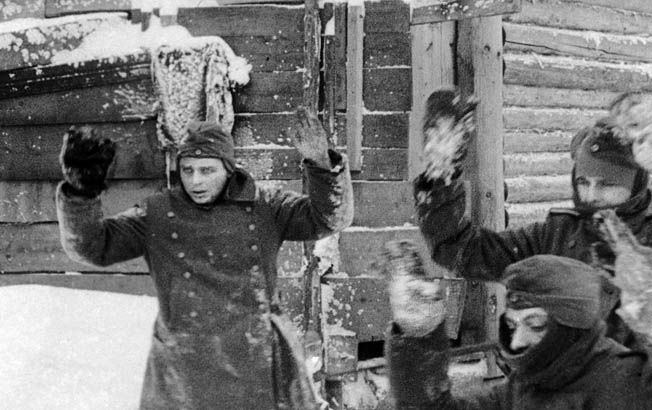
At the same time, the 3rd and 13th Armies would attack General der Panzertruppen Rudolf Schmidt’s 2nd Army on the army group’s southern flank while the 31st and 29th Armies would attack Generaloberst Adolf Strauss’s 9th Army on the army group’s northern flank. Meanwhile, in the center the Soviet 5th, 33rd, 43rd, and 49th Armies would only demonstrate and not attack initially in order to discourage the transfer of German reinforcements to the north or south.
In phase two, after success on the flanks, the Red Army units in the center would go over to the offensive and accomplish the general destruction of von Bock’s Army Group Center. Zhukov’s eventual goal was to push the AGC front all the way back to the line Staraya Russa-Velikiye Luki-Vitebsk-Smolensk-Bryansk.
The offensive began at Kalinin, 100 miles northwest of Moscow, in deep snow and a temperature of -22 degrees Fahrenheit at 3 am on Friday, December 5, when the Kalinin Front’s 31st Army, commanded by Maj. Gen. Vasili Yushkevich, struck out across the Volga River ice from positions just south of the city. Just before noon the 31st’s running mate, Lt. Gen. Ivan Maslennikov’s 29th Army, struck out across the ice just north of the city held by Strauss’s 9th German Army.
The next morning the attack against the 3rd and 4th Panzer Armies commenced when the Western Front’s 30th Army, commanded by Maj. Gen. Dmitri Lelyushenko, attacked Reinhardt’s 3rd Panzer Army east of Klin.
At the same time, the 1st Shock Army, headed by Maj. Gen. Vasili Kuznetsov, attacked and fought its way into Yakhroma, while Lt. Gen. Andrei Vlasov’s 20th Army hit Hoepner’s 4th Panzer Army at Krasnaya Polyana. At first light on the 7th, Lt. Gen. Konstantin Rokossovsky’s 16th Army smashed into other 4th Panzer Army elements near Khimki.
South of Moscow the Soviet offensive began on December 6. On the left flank of the Western Front the 10th Army, commanded by Lt. Gen. Filipp Golikov, attacked Guderian’s 2nd Panzer Army at Mikhailov, while Maj. Gen. Pavel Belov’s independent 1st Guards Cavalry Corps hit Guderian’s formations at Kashira.
Tula, 100 miles south of Moscow and 90 percent encircled by 2nd Panzer Army for weeks, was held by Lt. Gen. Ivan Boldin’s 50th Army, which attacked southeastward into the encircling ring on the afternoon of the 8th. Its aim was to cut off the retreat of any German forces north and east of Tula.
Finally, on the far south wing of AGC, the 13th Army, under Maj. Gen. Avksenti Gorodianskiy, struck Schmidt’s 2nd Army on both sides of Yelets, 220 miles south of Moscow, on 7 December—the same day Japanese forces were attacking Pearl Harbor. This was followed the next day by Maj. Gen. Yakov Kreizer’s 3rd Army attack on Yefremov.
Almost the entire front around Moscow, which was covered in several feet of snow and constantly subjected to blizzard conditions, was, by the end of the first week of December, fully in flames. From Kalinin in the north 320 miles south to Yelets, the Germans and the Soviets were fully engaged in mortal combat.
On the northern flank, Generaloberst Adolf Strauss’s 9th Army had managed to hold off the 29th and 31st Armies on December 6 and keep them from closing their encirclement of Kalinin. In this Strauss got generous help from the Luftwaffe, which had a great deal of immobile equipment and temporarily non-airworthy aircraft at Kalinin.
Reinhardt’s 3rd and Hoepner’s 4th Panzer Armies had already begun pulling back from their exposed forward positions and were going over to the defense when the Soviets struck. On the morning of the 7th, the roads leading to Klin from the east were packed with 3rd Panzer Army rear echelon troops heading west. Many guns and much equipment, not to mention tanks, were left behind because motors and transmissions were frozen. There was very little gasoline, and unless a motor was left running constantly it would freeze up. The men had to leave, but much of their equipment could not. The 1st Shock Army followed hesitantly from its breakthrough at Yakhroma.
The bigger threat to Reinhardt’s 3rd Panzer Army at the moment was from Lelyushenko’s 30th Army, farther north. The 30th broke through at Rogachevo and surged eight miles that first day, approaching Klin from the northeast. The next morning the lead detachment surprised the LVI Panzer Corps headquarters at Bolshoye Shchapovo, barely three miles northeast of Klin. (Note that the German Panzer Corps had all originally been named Motorized Army Corps [A.K. (Mot.)]. They were all renamed Panzer Corps at various dates in 1942. For clarity, all are here referred to as Panzer Corps.)
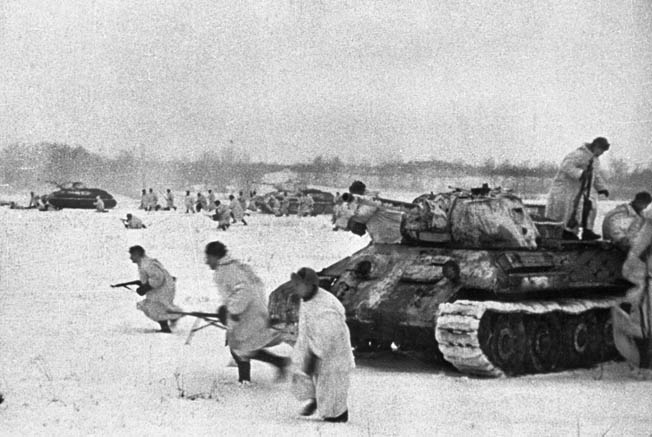
The corps commander, General der Panzertruppen Ferdinand Schaal, was seen dispensing aimed fire from his carbine as he fled. The next day the Russians cut the main north-south highway three miles northwest of Klin as thousands of German troops squeezed through the town, flooding west. Klin was the main crossroads point north of Moscow through which most all German troops in the area had to withdraw; it must be held as long as possible.
South of 3rd Panzer Army, Hoepner’s 4th Panzer Army had initially fared a bit better. His troops were holding off the Soviet 20th Army east of Solnechnogorsk, and the 1st Shock Army was moving only cautiously along the 4th’s northern boundary with 3rd Panzer Army. In fact, 1st Shock was moving so slowly that Zhukov ordered it to pick up its pace on December 7.
That same day, Rokossovsky’s 16th Army joined the attack. The 16th was one of the best equipped Soviet armies of the Western Front and showed it that first day, surging some 20 miles and capturing Kryukovo on the 8th.
In the center of the army group front, von Kluge’s 4th Army, the last army to halt its attack on Moscow, was initially very fortunate. As mentioned, the Soviet units opposite 4th Army were not to attack initially––only “demonstrate,” and most did little of that. Consequently, 4th Army had a chance to dig in and consolidate its front. They were even able to spend some time reconnoitering and improving the “Winter Line” positions to the west into which they expected to withdraw.
German aerial reconnaissance reported many trains converging on Moscow from all points, and signal intelligence indicated that there were at least 25 more enemy divisions and brigades on the radio in the army group area than there had been a month before. Von Bock had opined a week earlier that the enemy had no more fresh units to oppose his forces; only by stripping units from other fronts could they bring more troops to combat against AGC. Today he was rethinking that position and trying to scrape up reserves wherever he might find them.
When Generaloberst Franz Halder, the chief of the Army General Staff, told von Bock not to expect any replacement battalions before mid-January, von Bock replied that he didn’t need replacements—he needed trained, fully equipped divisions! Halder informed von Bock he simply did not have any of those to offer.
All up and down the front a fundamental transportation problem had cropped up for the first time. Ever since the invasion of the Soviet Union in June, German railroad workers had been busy converting the wide Russian railroad tracks to the narrower gauge used on the Continent so that their German trains could deliver guns, supplies, and troops from their point of origin all the way to any destination in Russia without having to unload then reload on wider gauge cars at some point.
Ironically, the brutal winter of 1941-1942 made that effort problematic because it was discovered that only the insulated Russian locomotives could hold steam in the sub-zero weather. So, just when the Germans needed it most, a large part of their transportation system failed.
For just one day, December 8, the temperature rose above freezing throughout the Moscow area, and the snow turned to freezing rain. The ground itself and everything on it was still quite cold, so everything that was rained upon developed a not-so-thin covering of ice. It was inconvenient for all, but more so for the Germans since they were forced to improvise many of the things that they needed.
In another surprising consequence of the weather, most telephone and telegraph lines, weighted down by the heavy ice, broke and fell, further complicating an already chaotic situation.
South of Moscow, Guderian’s 2nd Panzer Army had already begun to withdraw from its forward positions when the Soviets attacked on the 6th. Just like 3rd and 4th Panzer Armies north of Moscow, the 2nd Panzer Army’s attack had earlier ground to a halt, and it was trying to secure the front for the winter. Having just broken off their own attack, many of Guderian’s units had their assault forces up front and well positioned to hit the enemy’s initial attacks.
At Tula, XXIV Panzer Corps’ 3rd Panzer Division and 296th Infantry Division had blocked the Soviet 50th Army when it tried to break out to the southeast. Fifty miles to the east, the 10th Motorized Infantry Division was successfully slowing down the Soviet 10th Army at Mikhailov, and north of Venev the 17th Panzer Division had held off the 1st Guards Cavalry Corps for a full day.
Unfortunately for Guderian, the Soviet 50th Army eventually found success when it redirected its attack, and by the 10th it had penetrated a seam between the XLIII Army Corps and XXIV Panzer Corps west of Tula.
Farther south, Rudolf Schmidt’s 2nd Army wasn’t faring quite so well. His army had basically been filling the gap between 2nd Panzer Army and Army Group South’s northernmost unit—Walter von Reichenau’s 6th Army—and held a 180-mile front with just seven divisions.
When the enemy was reeling from heavy blows delivered by German units, a division holding a 25-mile front was not too much of a problem, but when that enemy was attacking and looking to penetrate, it was definitely a problem.
The Soviet 13th Army had penetrated the XXXIV Army Corps on both sides of Yelets and by the 8th had captured Yelets and forged a 50-mile-deep penetration toward Novosil. The flanks of the penetration were, of course, vulnerable, but General Schmidt could not take advantage because his vehicles had little fuel.
Despite these successes on the south flank, Zhukov was not happy about what he considered his armies’ tactical shortcomings. On the 9th he issued a directive to all his forces telling them to stop trying to push the enemy back frontally, for this only gave them an opportunity to regroup and redeploy to new positions. Instead, they should penetrate the enemy’s front and drive deep into his rear, destroy his artillery, and cut him off.
The Germans were becoming desperate. The troops were exhausted, their units under-strength and ill equipped, and they were at the end of a 1,000-mile supply line that had completely broken down. Typhus was spreading like wildfire thanks to the body lice and other vermin the troops had to live with. Unfortunately, there was only enough typhus serum to inoculate medical personnel and troops over 45 years of age.
The German troops marveled at the Russian winter uniforms—felt-lined boots, fur caps, and quilted tunics––while they toiled in worn-out boots, threadbare summer uniforms, and no heavy coats. Discipline was breaking down, troops were walking west on their own without weapons, foraging for food. Guderian described his army as a scattered assemblage of armed baggage trains slowly wending their way to the rear.
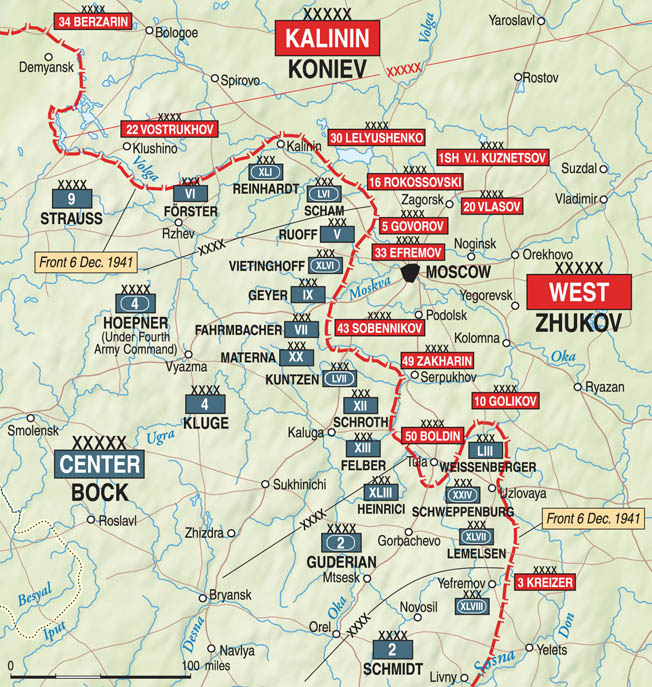
On December 8, Hitler issued his Directive No. 39 for the winter campaign. He said that because of the early onset of cold weather and consequent problems with supply, all offensive operations were to cease, and units would go over to defensive positions. But only minimal withdrawals were to be made and only when absolutely necessary, and then only when new positions had been prepared.
The generals were becoming deeply concerned. Was Hitler getting an accurate picture of their situation? Did anyone in Berlin actually know what was going on at Moscow?
On the 13th, the commander of the German Army, Generalfeldmarschall Walther von Brauchitsch, visited AGC headquarters at Smolensk to meet with the generals. He told von Bock that OKH (Army high command) and Hitler were fully aware of the Army Group’s struggles against the enemy and nature. Bock told him that the way things were going his troops would be destroyed in eight to 10 days and that it was therefore necessary to withdraw to the Königsberg Line: Rzhev-Gzhatsk-Orel-Kursk and, if necessary, to sacrifice equipment to save the men.
After visiting von Kluge and Guderian in Roslavl, Brauchitsch returned to Smolensk and told von Bock that he agreed to the withdrawal von Bock had proposed. Unfortunately, as soon as Hitler heard about the withdrawal, he said, “No!” He said the panzer armies were allowed to pull back from Kalinin, Klin, and Tula in order to straighten their lines, but he forbade any general withdrawal—at least until fighting positions had been prepared into which the units could withdraw.
Bock hadn’t spoken to Hitler directly, so he felt free to assume that the beginning of “some” preparations would satisfy him and thus ordered his armies to begin such preparations to the extent possible and to prepare to withdraw.
By December 15, the last units of 3rd Panzer Army had fought their way through Klin in fierce combat against units of both the 30th Army and 1st Shock Army. Units of the XLI Panzer Corps were the last troops through the bottleneck, and the corps commander, General der Panzertruppen Walter Model, could be found personally directing traffic there until the last units were through.
Most of the army was able to break loose from the pursuing enemy and take up positions along the west bank of the Lama River, north of Volokolamsk.
To the south, all units of Hoepner’s 4th Panzer Army had managed to gain positions behind the Istra River/Reservoir while being pursued by the 16th and 20th Armies, but they would soon withdraw to the Lama/Ruza River line to conform to their northern neighbor. Strauss’s 9th Army had likewise withdrawn from Kalinin after setting demolition charges on anything worth having, including the large bridge over the Volga River in the center of town.
To the south of Moscow, Guderian’s 2nd Panzer Army had been penetrated by Ivan Boldin’s 50th Army, and a gap was opening up at Dubna between XXIV Panzer Corps and XLIII Army Corps to its north. Most units of the army were trying to establish a line behind the Plava River, but withdrawal to the line of the Oka and Susha Rivers, 35 miles to the west, was being contemplated as the enemy’s 10th Army and 1st Guards Cavalry Corps were bearing down on the Plava River with little to stop them.
Farther south in the 2nd Army’s area lay the greatest threat to the army group at the moment. Presumably that is why it was the first to receive any reinforcements, meager as they were. The XXXIV Army Corps had been dispersed and deeply penetrated west of Yelets, with most combat elements encircled and destroyed. This represented a threat to Orel and Kursk, two of the most important supply points for Army Group Center and Army Group South. The weakened state of the army made it questionable whether it could successfully defend these vital hubs.
On the 12th, reinforcements had begun to arrive for Schmidt’s 2nd Army, including remnants of a battered infantry division from 2nd Panzer Army, a security division of overage troops from railroad security duty in the army group rear area, two reinforced infantry regiments from two different divisions from Army Group South, and an SS motorized brigade fresh from antipartisan duty in the rear.
This motley collection was assigned to XXXV Army Corps and, along with other units of the corps, took up positions at Verkhovye on the main east-west road and railroad 48 miles east of Orel. On the 17th, to most everyone’s surprise, they managed to halt the Soviet penetration, at least temporarily.
At about that same time, Bock put 2nd Army under command of 2nd Panzer Army, creating Army Group Guderian, in the hope that this arrangement would prevent Guderian from withdrawing without consideration for his neighbor to the south.
Now, with both the northern and southern wings of AGC around Moscow either pushed back or destroyed, General Halder declared it the worst crisis in two world wars, and Zhukov ordered the second phase of the attack to begin. A great victory had been achieved, and now Zhukov expected to raise that to the monumental level with the complete destruction of Army Group Center.
German commanders at all levels had been clamoring for permission to withdraw; Hitler, for the most part, had said no, allowing only minor rearward movement on a limited basis.
Finally, on December 18, he released a definitive order on the subject: “Larger evasive movements cannot be made. They would lead to a total loss of heavy weapons and equipment. Commanding generals, commanders, and officers are to intervene in person to compel the troops to fanatical resistance in their positions without regard to an enemy break though on the flanks or in the rear.
“This is the only way to gain the time necessary to bring up the reinforcements from Germany and the West that I have ordered. Only if reserves have moved into rearward positions can thought be given to withdrawing to those positions.”
Reaction to what became known as the “stand-fast” order among the generals ranged from resignation to outright rejection. Von Kluge predicted that regardless of orders the army group could not hold the line; both Reinhardt and Hoepner doubted that their divisions could be made to stop on the Lama-Ruza line, and Guderian said flatly that he would not even pass the order on.
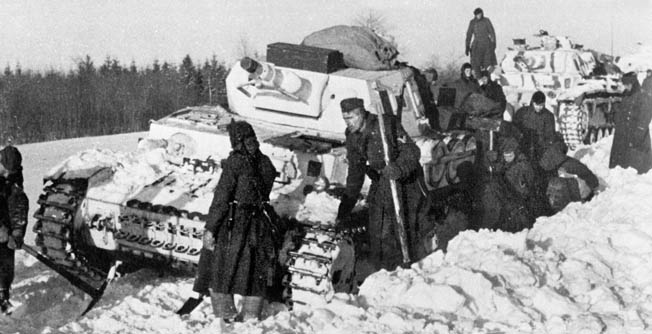
Bock opined that it was impossible to tell which was more dangerous—to hold or to withdraw. Either way, his army group was likely to be destroyed.
The next day Bock went on sick leave and left for Germany; Generalfeldmarschall von Kluge would leave 4th Army and take over command of the army group. Also leaving on the 19th was Commander of the army, Generalfeldmarschall von Brauchitsch; he, too, was in failing health and, frustrated that he had been cut out of important decisions, submitted his resignation. Not only did Hitler accept von Brauchitsch’s resignation, he took over command of the army himself.
For the most part, the generals were notsure what to make of Hitler taking over command of the army. Some thought that the army would loose its identity, while others thought that it was good since now they could be assured that the army leadership was not keeping their demands, or concerns, or advice from Hitler.
Among the rank and file it was virtually unanimous—they were delighted; they had complete faith in Hitler, and any doubts that they had quickly turned into optimism.
But at the front the troops were still hard pressed, particularly on the southern flank near Guderian’s 2nd Panzer Army. The penetration between the Army’s XXIV Panzer Corps and XLIII Army Corps on the Army’s northern flank had grown to almost 30 miles wide.
Hitler urged Guderian to close the gap, but Guderian said it couldn’t be done from the south; all roads were poor quality and covered in drifted snow several meters deep. On the 18th the XLIII Army Corps was transferred to von Kluge’s 4th Army, so now the gap was between 2nd Panzer Army and 4th Army and an army group problem rather than just a 2nd Panzer Army problem. The next day, XXIV Panzer Corps and its badly battered panzer divisions were pulled off the front and sent to Orel for a quick, emergency refit.
When XXIV Panzer Corps was withdrawn, LIII Army Corps, commanded by General der Infantrie Walther Fischer von Weikersthal, took over the northern half of the 2nd Panzer Army front. The corps’ units were desperately trying to build a front along the west side of the Plava River when, on December 22, the 296th Infantry Division was deeply penetrated by troops of the Soviet 10th Army charging across the frozen river.
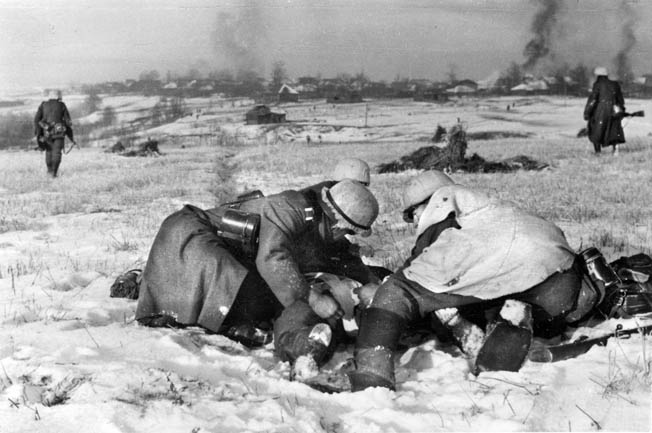
The next day the neighboring 167th Infantry Division was virtually destroyed. Fearing his division would be encircled and destroyed, Generalleutnant Wilhelm Stemmermann, commander of the 296th, ordered his units to fall back to the next defensible position—along the Oka River at Belev, over 40 miles to the west.
Guderian immediately used the 296th’s unauthorized withdrawal as justification for withdrawing the remainder of his front back to the Oka/Susha River line. In the fall the army had built some positions along the river line as it advanced and could reoccupy them now, he argued. Von Kluge said absolutely no, not without Hitler’s consent—and Hitler told Guderian to leave his front exactly where it was.
Over the next few days 2nd Panzer Army continued its withdrawal to the Oka/Susha line while von Kluge and Guderian sparred over it from afar. Von Kluge complained to Halder and to Hitler that Guderian refused to follow orders, that he did as he pleased, and filed misleading reports. Guderian told von Kluge, “In these unusual circumstances, I lead my army in a manner I can justify to my conscience.” The two men would have very strained relations throughout the war, von Kluge even challenging Guderian to a duel in 1943.
Von Kluge called Halder at 10 minutes to midnight on Christmas Eve and informed him that Guderian had asked to be relieved and court-martialed. The next day Hitler relieved Guderian and replaced him with Rudolf Schmidt from the 2nd Army.
By the end of the year, all units of the 2nd Panzer Army were fairly well entrenched along the western bank of the Oka and Susha Rivers from Belev south to the 2nd Army front near Novosil.
The beginning of phase two of the Soviet attack on December 18 meant that the Soviet armies facing the middle of Army Group Center all swung into action. The 4th Army bore the brunt of these attacks and held up fairly well, at least initially.
The Soviet 33rd Army, commanded by Lt. Gen. Mikhail Yefremov, and 43rd Army, commanded by Maj. Gen. Konstantin Golubev, struck XX Army Corps units and LVII Panzer Corps units along the Nara River on either side of Naro-Fominsk and quickly became bogged down in the extensive defensive positions along the river.
To the south, Lt. Gen. Ivan Zakharkin’s 49th Army hit XIII Army Corps units on both sides of Tarusa and also gained little ground. North of 4th Army, the 4th Panzer Army’s VII Army Corps also held off the initial attack by Lt. Gen. Leonid Govorov’s 5th Army, northeast of Moshaisk. The German units immediately west of Moscow had had some time to build defensive positions.
There was a brief glimmer of hope as farther north on the left flank of 4th Panzer Army and in the 3rd Panzer Army sector units of the XLI and LVI Panzer Corps, after withdrawing from Klin, had been able to settle in on the west side of the Lama River north from Volokolamsk.
South of there, the XLVI Panzer Corps held the line along the west bank of the Ruza River. The troops had broken contact with the pursuing enemy during the withdrawal and reached the river line a day or two ahead of the Soviets. This gave them a chance to catch their breath, get some sleep, and enjoy hot food for the first time in several days.
In the far northeast corner of the army group front, 9th Army units withdrawing southwestward away from Kalinin were hotly pursued by elements of the Soviet 29th and 31st Armies. The Soviet 30th Army, transferred from the Western Front to the Kalinin Front, was also closing in from the east.
The primeval wilderness, full of frozen swamp and dense forest, was equally difficult for both pursued and pursuer, but the Soviets’ extensive use of sledge columns to bring forward food and ammunition gave them a distinct advantage.
Hitler had previously given permission for Strauss to pull his 9th Army’s northeast corner back from Kalinin to Staritsa, but the commander wanted to keep going to the Königsberg Line.
Strauss flew to army group headquarters on the 21st to plead his case. He told von Kluge that Staritsa was just a spot on Hitler’s map, that it had no value at all; on the ground it was nothing more than a clearing in the woods. Strauss wanted to continue southwestward to Rzhev, where there were at least some facilities and communication assets.
Rzhev was the northern anchor of the Königsberg Line—Rzhev-Gzhatsk-Orel-Kursk—where some defensive positions had previously been completed. Von Kluge told Strauss he could withdraw only if Hitler agreed, which of course he did not.
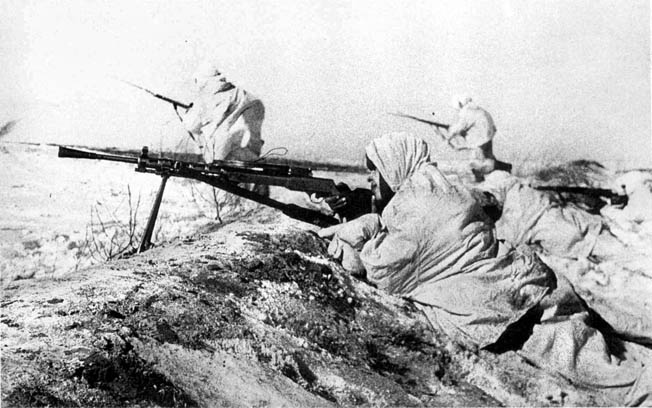
At that point the 9th Army front, which began as a squared-off corner with an east-facing front and a north-facing front, had become a northeast-facing diagonal line from its connection with 3rd Panzer Army north of Volokolamsk northwestward past Staritsa to Army Group North at Ostashkov.
The last 10 days of the year were some of the most difficult the army group had faced since the beginning of the war; many thought that it was about to disintegrate.
On December 22, in a freak accident, the very able chief of staff of the 4th Army, Generalmajor Günther Blumentritt, was run over by a truck in the darkness and medically evacuated. Consequently, when von Kluge’s replacement, General der Gebirgstruppe (Mountain Troops) Ludwig Kübler, arrived four days later, he had no chief of staff to orient him to the situation.
One of Kübler’s first orders of business was to determine how best to defend his own headquarters in Yukhnov. The 4th Army HQ had been forced to flee Maloyaroslavets on Christmas Day, and now Soviet cavalry was surging through the gap on 4th Army’s south flank toward Yukhnov.
By the end of 1941, Kübler’s 4th Army had a large gap on each flank; in the north there was a 13-mile gap between LVII Panzer Corps units west of Maloyaroslavets and 4th Panzer Army units at Borovsk; in the south there was the huge 50-mile gap between XLIII Army Corps units just west of Kaluga and 2nd Panzer Army units at Belev. The Soviet 43rd Army was pouring through the northern gap while the 10th Army, 50th Army, and 1st Guards Cavalry Corps surged through the southern.
On December 26, the 39th Army, now commanded by Lt. Gen. Ivan Maslennikov, joined the attack, hitting 9th Army’s VI Army Corps northwest of Staritsa. Maslennikov had begun the offensive as commander of 29th Army, but on December 11 he was replaced by Maj. Gen. Vasili Shvetsov, and at the same time he replaced Lt. Gen. Ivan Bogdanov at 39th Army.
The VI Army Corps’ 26th Infantry Division initially maintained the upper hand, but there were alarming reports coming from the field. The 6th Infantry Division reported its men physically and psychologically finished. Men’s boots were frozen to their feet, machine guns were frozen and did not work, radios were frozen and inoperable.
On December 29, General Strauss reported that Staritsa was almost surrounded and that the VI Army Corps was falling back toward Rzhev as 39th Army continued southward. Hitler was furious and, in a fit of pique, relieved the corps commander, General der Pionere (Engineers) Otto Foerster, and replaced him with the commander of the army groups’ air support, Luftwaffe General der Flieger Wolfram von Richthofen, and ordered him to hold the line.
The 3rd and 4th Panzer Armies’ front along the Lama and Ruza Rivers remained fairly stable even after the Soviets caught up with the withdrawing Germans, who put up a tenacious defense that the enemy could not penetrate—the one exception being in the 4th Panzer Army’s V Army Corps sector where the 106th Infantry Division was pushed out of Volokolamsk on December 21. They managed to stabilize the front just west of there but on Christmas Eve,Soviet tank units found a soft spot and forced a penetration.
Fortunately for the Germans, the corps was holding part of the 6th Panzer Division as a reserve, and it quickly counterattacked and eliminated the penetration.
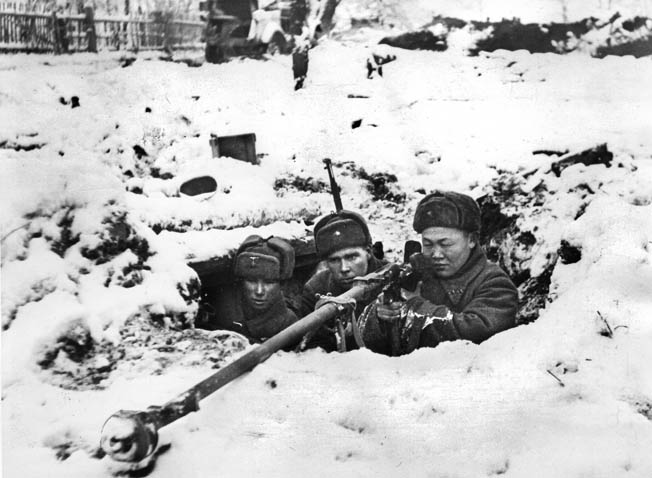
On the southern front, after Guderian’s firing, Army Group Guderian had become Army Group Schmidt, commanding both the 2nd Panzer Army and the 2nd Army. Other than the yawning gap on its north flank, 2nd Panzer Army now held a stable front along the west side of the Oka and Susha Rivers from Belev south to the 2nd Army front near Novosil.
The 2nd Army front, which ran from that boundary south to Army Group South near Tim, had settled down considerably by the end of the year. A minor penetration on Christmas Day near the village of Tim was cleared up by the 3rd Panzer Division, and the front grew quiet. About the middle of January, 2nd Army was transferred to Army Group South and was no longer a part of the Moscow counteroffensive.
On January 7, the Germans got a huge break when, with victory after victory and reports of German demoralization flowing in, Stalin saw an opportunity to expand the offensive and took command. Zhukov had saved Moscow; now Stalin wanted to grab some glory for himself. He envisioned not just pushing Army Group Center back but encircling and annihilating it along with Army Group North and Army Group South.
It would be a colossal undertaking involving nine of the 10 Soviet fronts making four large encirclements. A front was a Russian military formation roughly equivalent to an army group and generally contained three to five armies. It should not be confused with the term “military front,” which is a geographic area in wartime.
The Leningrad and Volkhov Fronts would encircle Army Group North and free Leningrad; the Northwest Front would help in the encirclement of Army Group North and send its left flank units on a deep outer encirclement of Army Group Center to close at Smolensk.
The Kalinin and Western Fronts would continue their operations against Army Group Center on an expanded basis; the Kalinin Front would battle against Army Group Center’s northern flank and send its right-flank units deep in an inner encirclement of Army Group Center to close at Vyazma. The Western Front would continue operations against the middle of Army Group Center and send its left-flank units to close the inner encirclement at Vyazma.
The Bryansk Front’s right-flank units would close the outer encirclement of Army Group Center at Smolensk while its left-flank units cooperated with the Southwest Front and the South Front in the encirclement of Army Group South. Finally, the Transcaucasus Front would continue operations in the Crimea and attempt to encircle General Erich von Manstein’s 11th Army there.
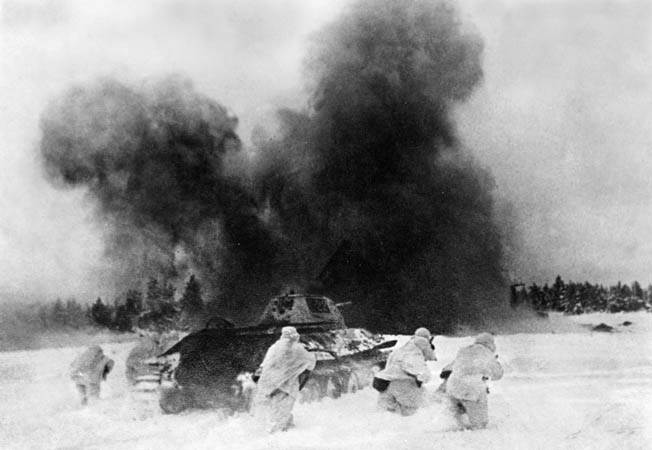
Operations against Army Group Center would have priority but would no longer have Stavka’s undivided attention. Soviet transport aircraft, which were used to supply troops and partisans in the hinterland and were already in short supply, would be dispersed to other fronts. Reserves and replacements, not to mention fuel and ammunition, would now be needed throughout, not just in the center. All sorts of support previously dedicated to operations against Army Group Center would now be spread throughout the country.
Unfortunately for the Soviets, offensive combat operations were still a fairly new proposition, and they made numerous elemental errors at all levels of command. They usually tried to bludgeon their way forward, seldom bothering to concentrate at a point of main effort. They habitually dispersed their armor and artillery and paid little attention to the coordination of the various combat arms. Their attacks always produced an inordinate number of casualties; manpower was their most abundant asset, and they treated it that way. The theater-wide offensive was an overreach by Stalin—and Soviet units throughout the country paid for it.
Most of the Soviet divisions attacking AGC had been in action for more than a month and were rapidly wearing down. Virtually all divisions were down to fewer than 4,000 troops, and most tank brigades had but one T-34 left. All this and the fact that a week later Hitler decided to allow the army group to withdraw to the Königsberg Line, virtually assured the survival of Army Group Center and made Hitler’s stand-fast order appear to be tactical genius.
The Germans, while still under immense pressure, were beginning to find their footing; they were actually receiving some reinforcements and settling down into positions along a new front. In some places the new front was not very far from the old front.
For instance, in mid-January in the 4th Panzer Army sector, the VII Army Corps was holding positions just east of Moshaisk, less than 12 miles west of the positions they held when the Soviet attack had begun in early December. After they withdrew into their Königsberg Line positions farther west on January 22, they would remain there, less than 50 miles west of where they started and less than 100 miles west of Moscow, until March 1943.
In the meantime, there was still much fighting and dying to be done.
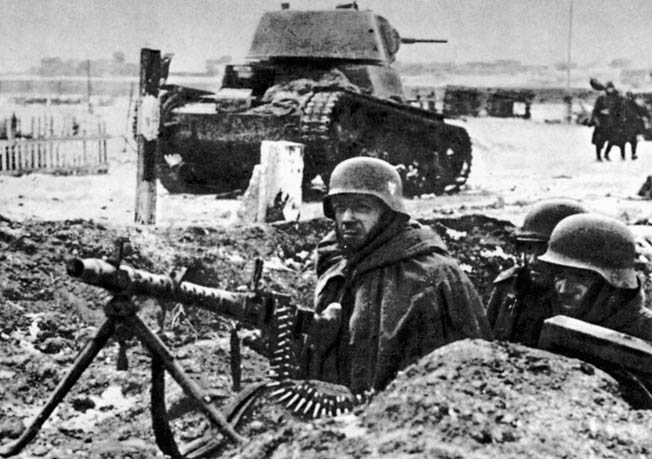
In another fortuitous circumstance, Generalfeldmarschall von Kluge had General Walter Model at hand when, on January 18, General Strauss asked to be relieved of command of 9th Army. Model, the 50-year-old commander of the XLI Panzer Corps, was a dynamic, energetic, ambitious commander and took over at a moment of great danger for 9th Army. The 9th Army’s VI Army Corps had been penetrated northwest of Rzhev, and the Soviet 39th Army was flowing southward just a few miles west of the Rzhev-Vyazma railroad while Shvetsov’s 29th Army prepared to follow.
Model’s first order of business was to restore the front where the enemy had penetrated, then eliminate the penetration. Right away Hitler tried to tell the new commander how to conduct his business and told Model that he must weaken his attack forces to insure the protection of Vyazma. Model immediately flew to Hitler’s headquarters and bluntly asked the dictator, “Who commands 9th Army, you or I?” Not used to this sort of reaction, Hitler meekly relented.
On January 23, Model’s counterattack west of Rzhev closed the gap between VI Army Corps and XXIII Army Corps and cut off the penetration by the Soviet 39th and 29th Armies. Thus began forming a huge pocket of enemy units behind the army group’s front.
Another element of this growing pocket behind the front were the 1,643 parachute and air-landed troops the Soviets inserted behind 4th Army in the third week of January. Expecting to fight disillusioned, fleeing Nazi troops, these soldiers instead faced determined attacks by disciplined troops consolidating their positions.
Partisans, too, were a large part of the growing presence behind the front. They had always been a part of the landscape, but with the insertion of uniformed Soviet troops the partisans became much better organized and equipped. Some military units even “drafted” local partisans into the ranks on the spot to make up for losses.
Another pocket of cut-off Soviet troops began forming south of Vyazma when the gap between 4th Panzer Army and 4th Army, through which Yefremov’s 33rd Army and part of Golubev’s 43rd Army had penetrated, was closed by a 20th Panzer Division attack on February 3. The 43rd tried unsuccessfully to reopen the breach from both sides, but the 33rd slowed to a stop, seemingly without a mission.
The huge gap south of 4th Army to 2nd Panzer Army was also slowly becoming re-populated by German troops. In about the middle of the gap lay the small town of Sukhinichi, where the German 216th Infantry Division had been encircled since late December. The Soviets never mounted a prepared attack to take Sukhinichi; they simply bounced off when they found the town defended and continued their attack westward. But the town was falling further and further behind the front. Something had to be done.
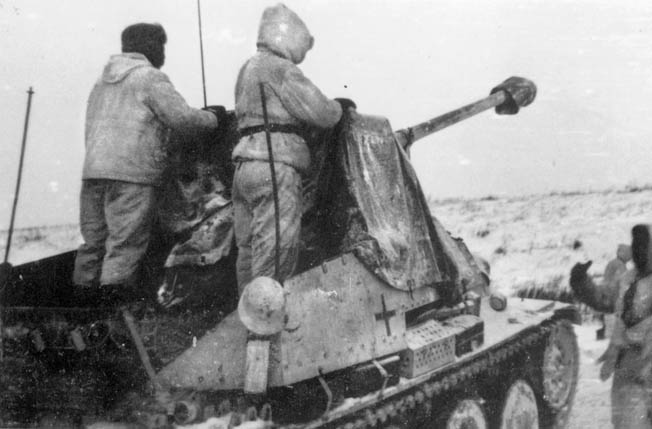
In mid-January, the XXIV Panzer Corps, commanded by Generalleutnant Willibald Baron von Langermann und Erlenkamp, with parts of two panzer divisions and an infantry division, launched an attack from Zhizdra to relieve the 216th and help it withdraw. Langermann’s troops reached Sukhinichi through chest-deep snow on January 24 and completed the withdrawal from there by the end of the month.
The corps and the troops thus released, as well as units arriving from France, then began forming an irregular front from 2nd Panzer Army’s LIII Army Corps near Belev northwest to the 4th Army boundary near Pesotschny.
The 4th Army’s XXXX Panzer Corps then took over and began forming a front curving northeastward to XLIII Army Corps units north of Mosalsk. This produced a large C-shaped bulge in the front that remained until 1943. The Soviet 49th and 50th Armies battered against the north edge of this bulge for weeks, trying unsuccessfully to sever the main 4th Army supply line from Roslavl.
Perhaps the most worrisome spot on the map in late January was in AGC’s deep northern flank, where the Soviet 4th Shock Army had penetrated the front near the boundary with Army Group North at Ostashkov. For two weeks, Col. Gen. Andrei Eremenko’s 4th Shock Army had been plunging southward, captured Toropets on January 21, and now approached Velizh, 60 miles northwest of Smolensk.
To confront this menace, Generalleutnant Kurt von der Chevallerie’s LIX Army Corps, with three fresh divisions from France, began arriving in the Vitebsk area on the 20th, and on February 1 the 3rd Panzer Army headquarters was transferred to Vitebsk to take charge of the defense of the army group’s deep northern flank.
During the first week of February, in a daring attack, General Model sent the XLVI Panzer Corps, now commanded by General der Panzertruppen Heinrich von Vietinghoff, to strike northwesterly across the northeast corner of 9th Army’s inside front southwest of Rzhev. In less than two days the panzer corps surged 30 miles between the Soviet 39th Army and 29th Army and contacted the XXIII Army Corps near Nikulino. This put most of Shvetsov’s 29th Army in a tight pocket, which was then quickly eliminated.
This victory allowed Model to shift forces and continue building his west-facing front south from Sychevka toward Vyazma. Model had earlier put Generalmajor Erhard Raus, the commander of the 6th Panzer Division, in charge of rounding up rear-area troops, convalescents, and any otherwise unattached troops to man the new west-facing front; by February 1, Raus had collected 35,000 troops to help man the line.
In the middle of February, with his offensive floundering, Stalin sent reinforcements to both Zhukov’s Western Front and Konev’s Kalinin Front and demanded that the front commanders bring all their forces to bear on the enemy, but it was too late. The troops were worn out, supplies were short, and the attack was inexorably losing steam. Nearly continuous attacks on both Rzhev and Vyazma had produced nothing but massive losses for the Soviets,in both men and materiel.
The Soviets’ situation got worse. By the third week of February, Lt. Gen. Mikhail Efremov’s 33rd Army was completely encircled southeast of Vyazma; Efremov would commit suicide in April when he and a group of his men tried unsuccessfully to escape.
On March 10, a massive late-season snowstorm roared into the area and halted all ground movement, leaving several feet of new snow on top of the several feet already there. But by the end of the month the temperature was rising above freezing, and the snow began to melt. The roads ran like rivers, the verges knee deep in muck. The muddy season was beginning, and all movement and combat slid to a halt.
Not only did the thaw produce problems for transportation, it also produced problems in sanitation and health as the bodies of thousands of men and horses long dead and frozen but unburied, began to thaw.
The Soviets had indeed pushed the Germans back, but they were far from destroyed. The greatest advance was made by the Soviet Western Front’s left flank, which advanced nearly 250 miles.
The shortest Red Army advance—about 50 miles—was made by the Western Front’s center armies. Between Vyazma and Smolensk, despite the insertion of thousands of paratroops and in weeks of heavy combat against scratch German units, elements of the Western Front were never able to effectively link up with units of the Kalinin Front to even temporarily achieve their primary objective of encircling von Kluge’s Army Group Center.
When the AGC front settled down, it resembled a giant upturned horseshoe. The straight line distance from AGC’s northern boundary at Veliki Luki south to Army Group South near Orel was 350 miles. But the actual front, with its convolutions, was closer to 1,000 miles long.
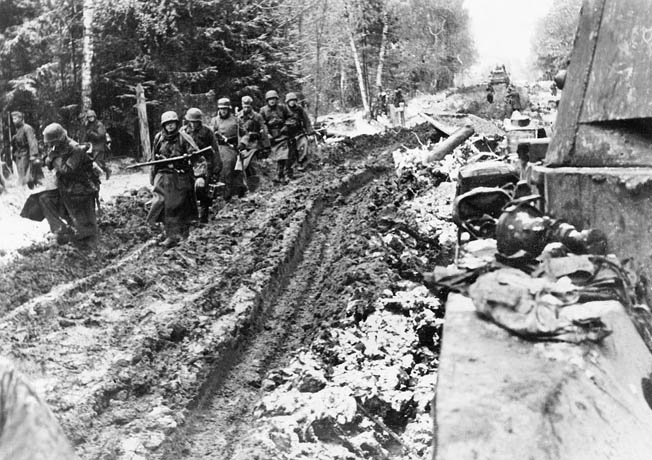
The left leg of the horseshoe ran roughly southwest from the Army Group North boundary at Veliki Luki to Nevel, then southeastward near Demidov. The line then ran east to a point about 20 miles northwest of Vyazma and turned north, becoming the western face of the right leg of the horseshoe. The open center of the horseshoe was the 150-mile by 150-mile Toropets Bulge.
The right leg of the horseshoe, which ran north on either side of the Vyazma-Rzhev railroad and was 50 miles wide at most, became known as the Rzhev Salient and was not entirely abandoned by the Germans until early 1943.
The C-shaped bulge around Sukhinichi also remained as part of the front between the 4th Army and 2nd Panzer Army. There were also vast pockets from various units, as well as paratroops and partisans, behind the front, which were gradually eliminated during 1942.
Zhukov’s offensive had retrieved Moscow from the enemy’s clutches, and the Soviet capital was never again threatened, but Stalin’s expanded offensive was a failure. From the start of the counteroffensive
on December 5 through April 20, Army Group Center had suffered 352,000 killed, wounded, sick, and missing. Losses for the Soviet forces engaged against AGC during the same period were 1,147,884, and considerably more for the overall offensive.
For the first time in the war the Soviets had undertaken offensive operations on a massive scale, and it did not go entirely well. They would, however, get better at it.
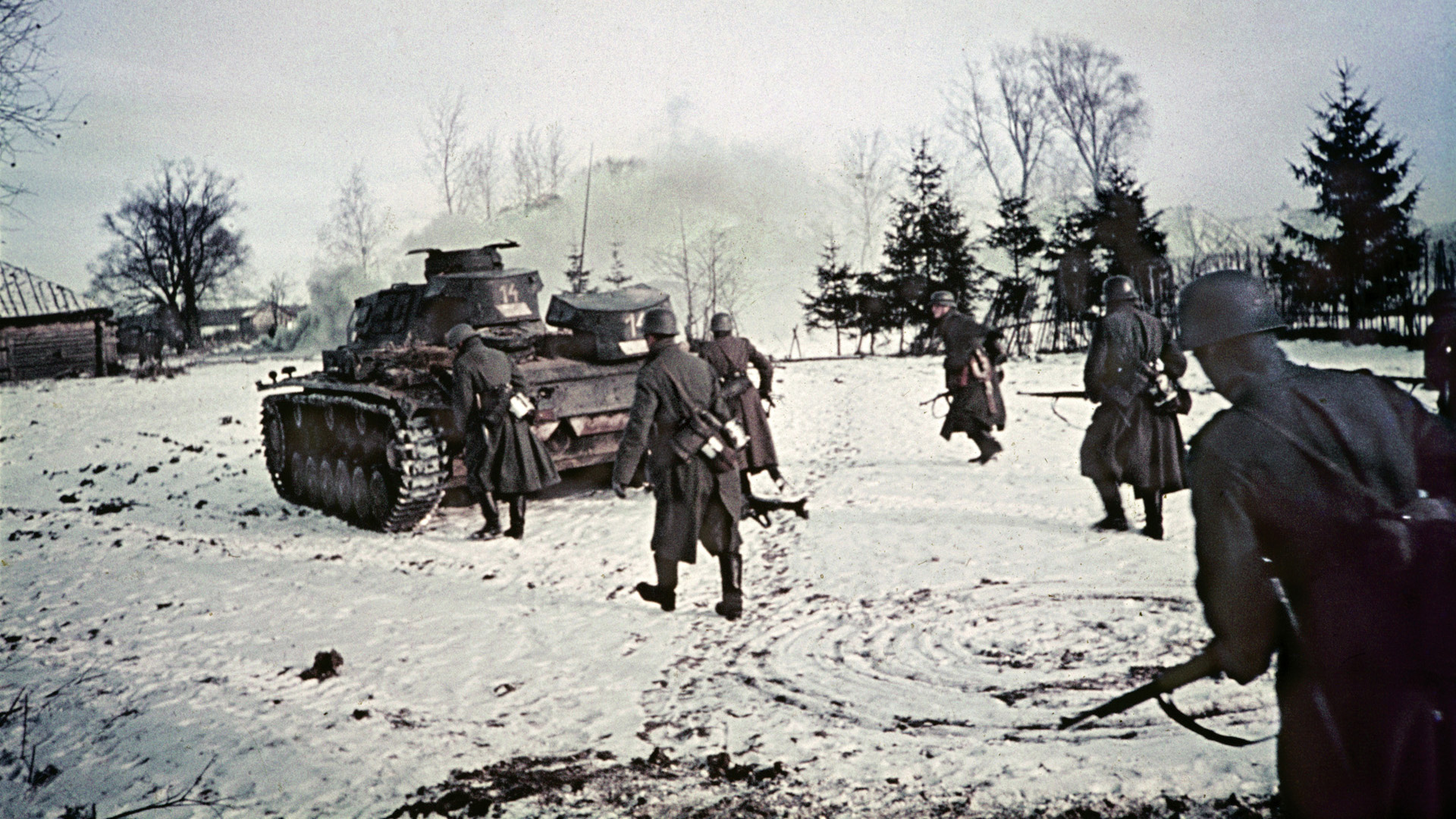
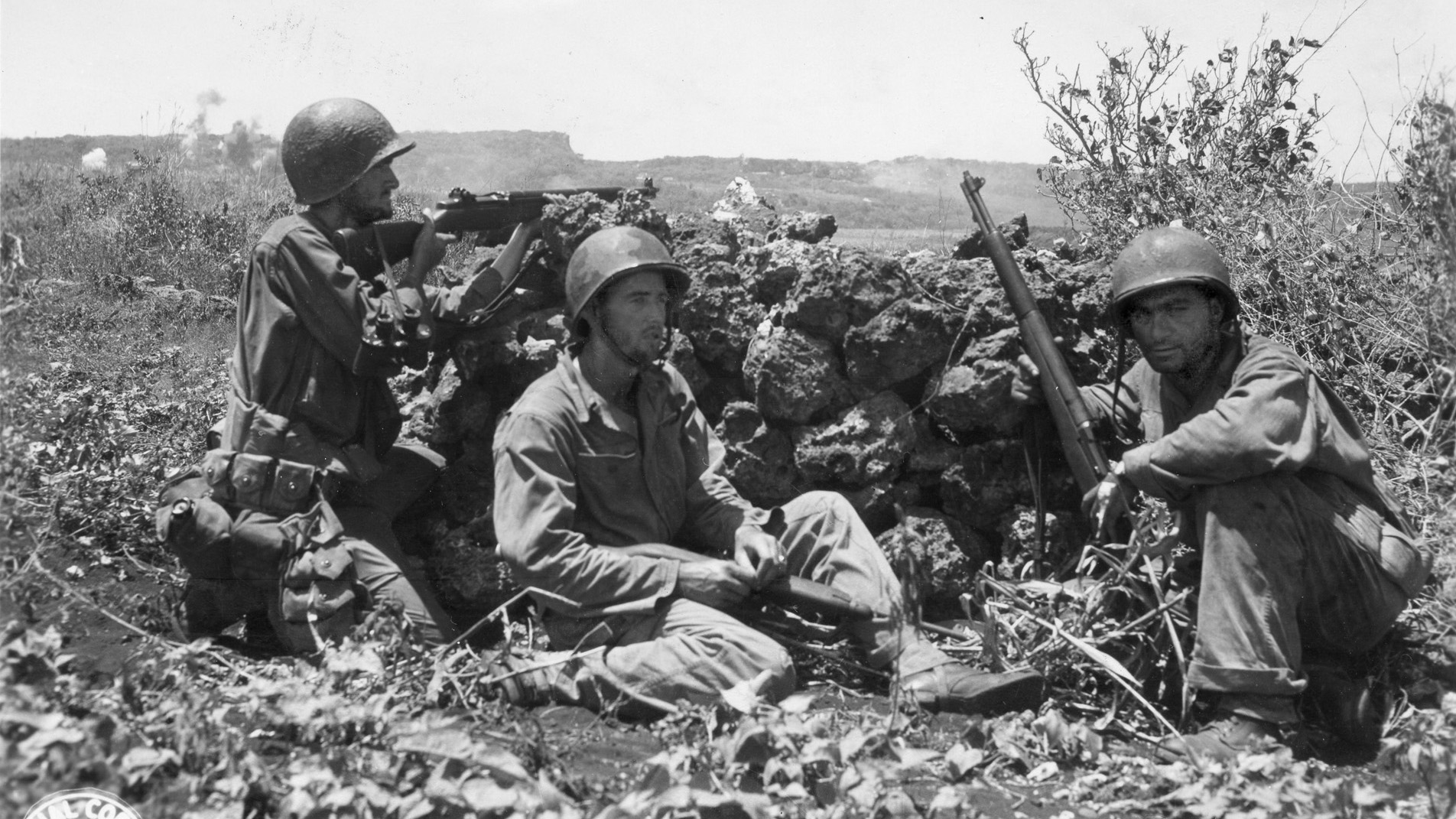
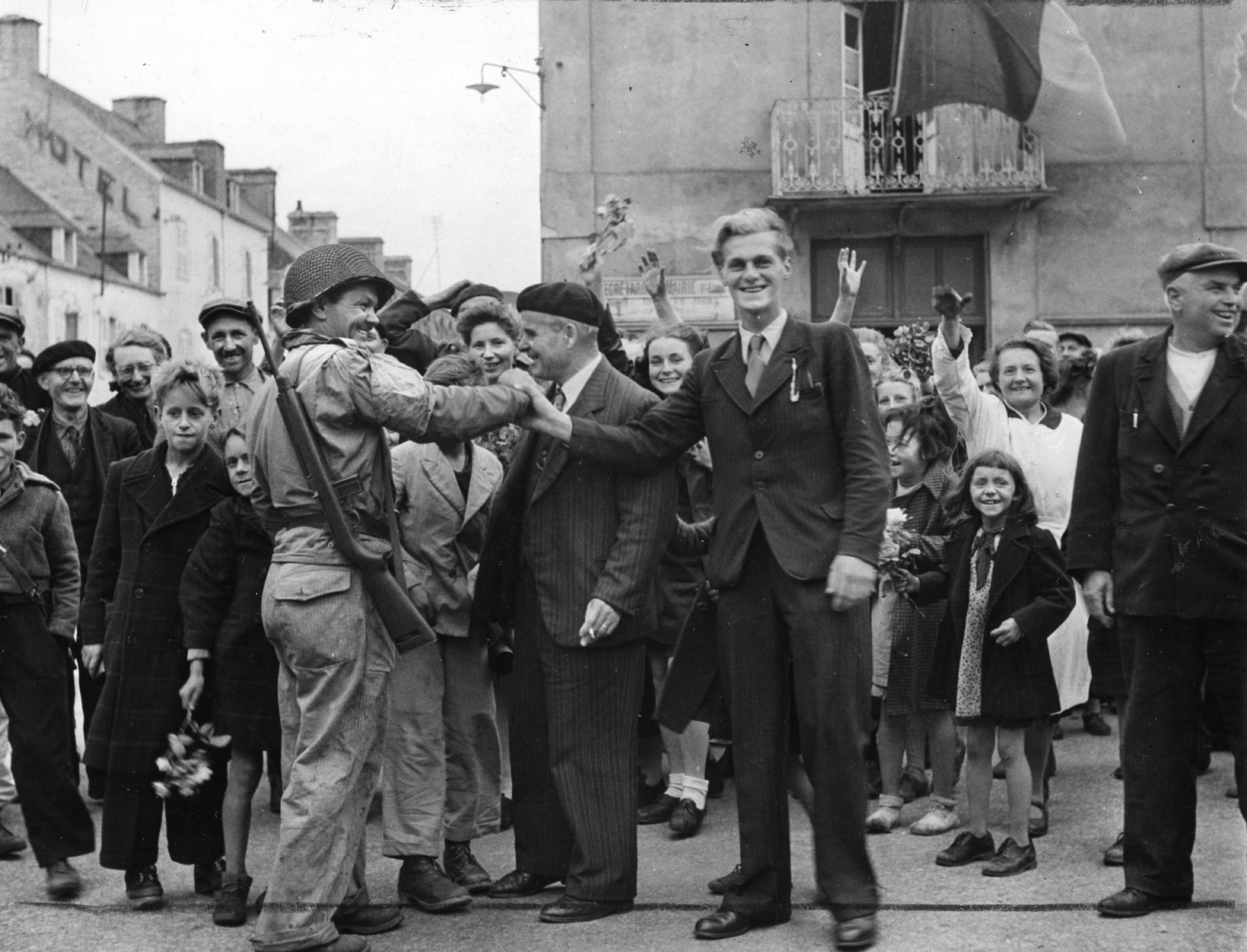
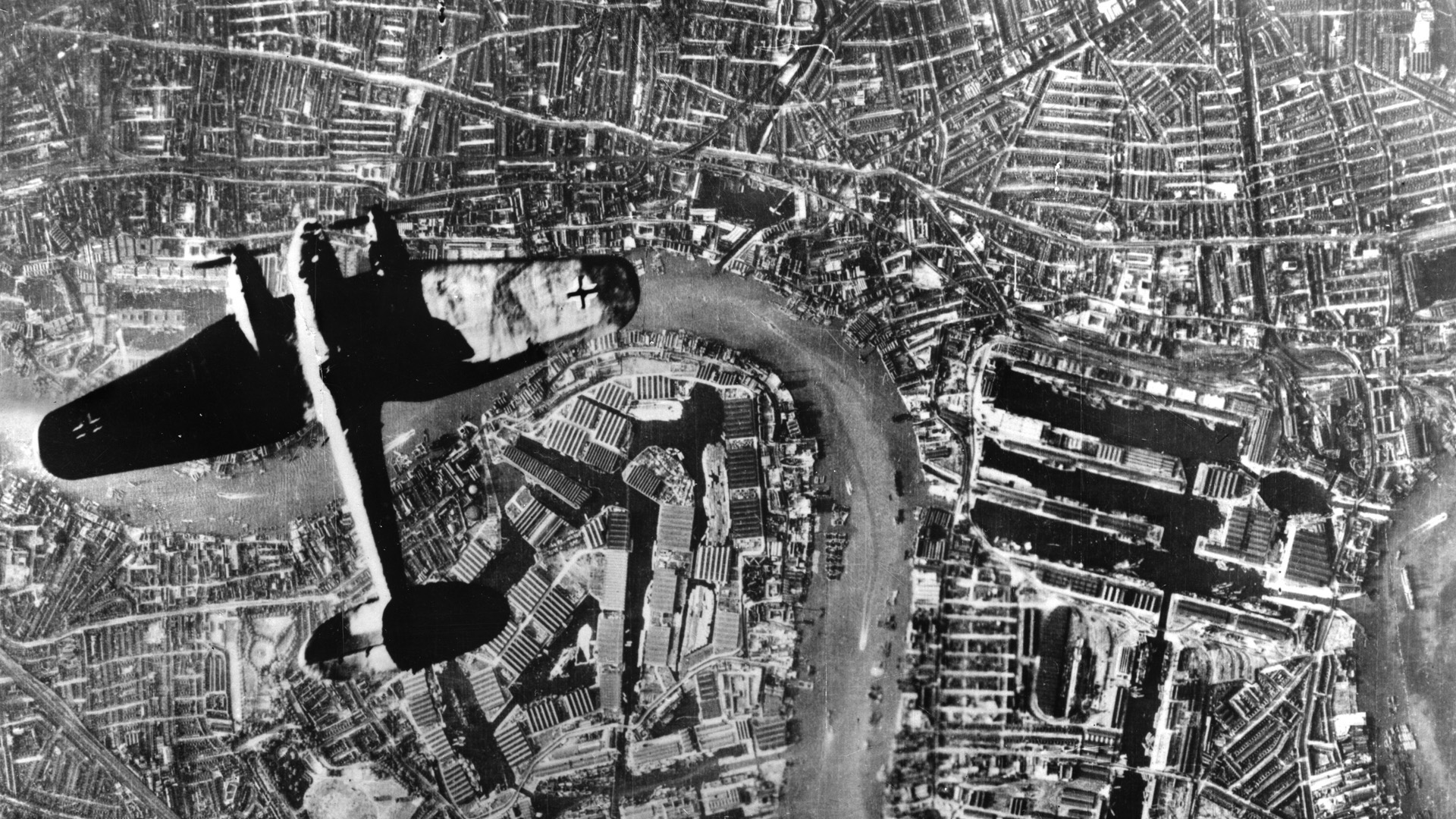
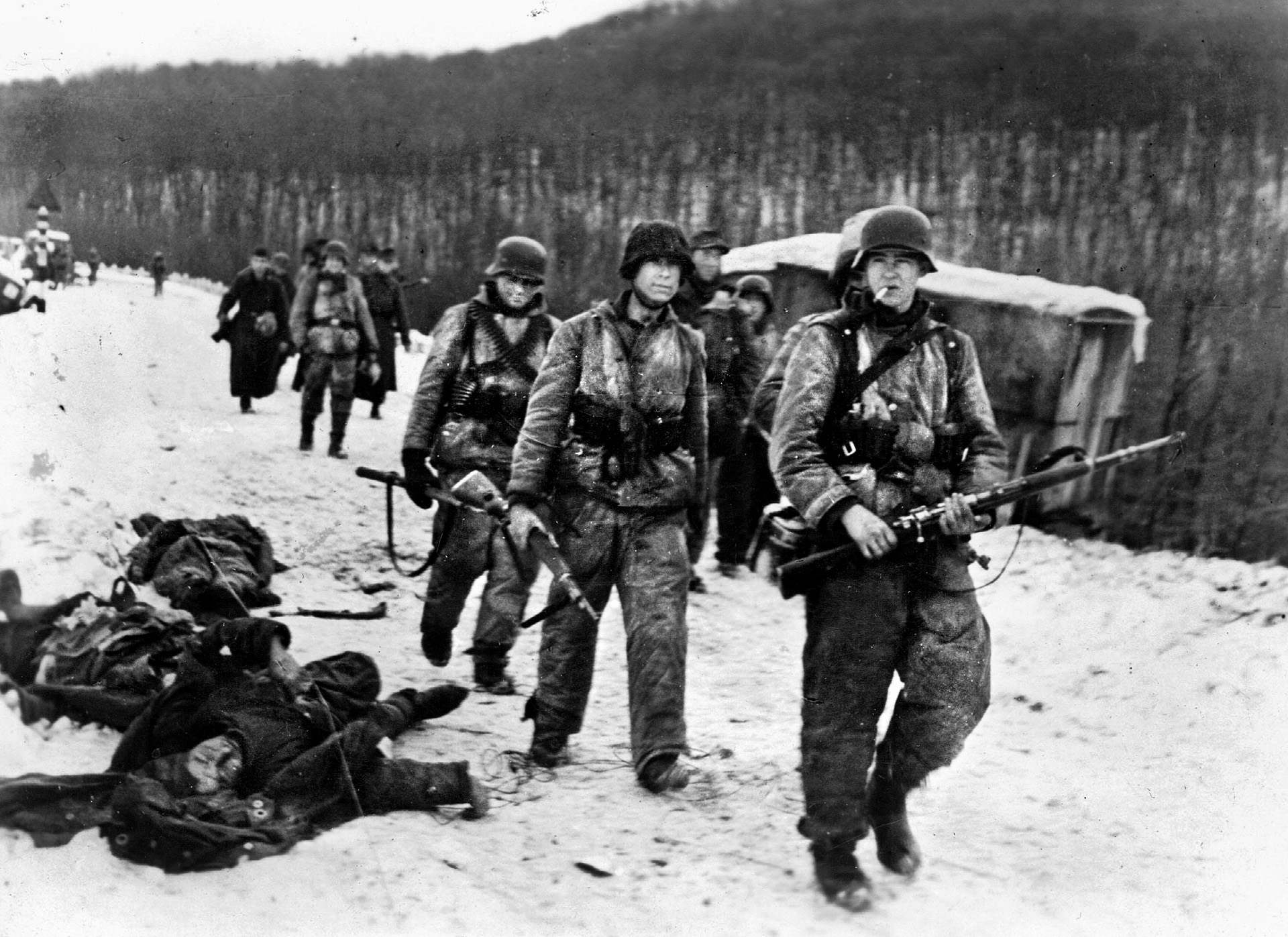
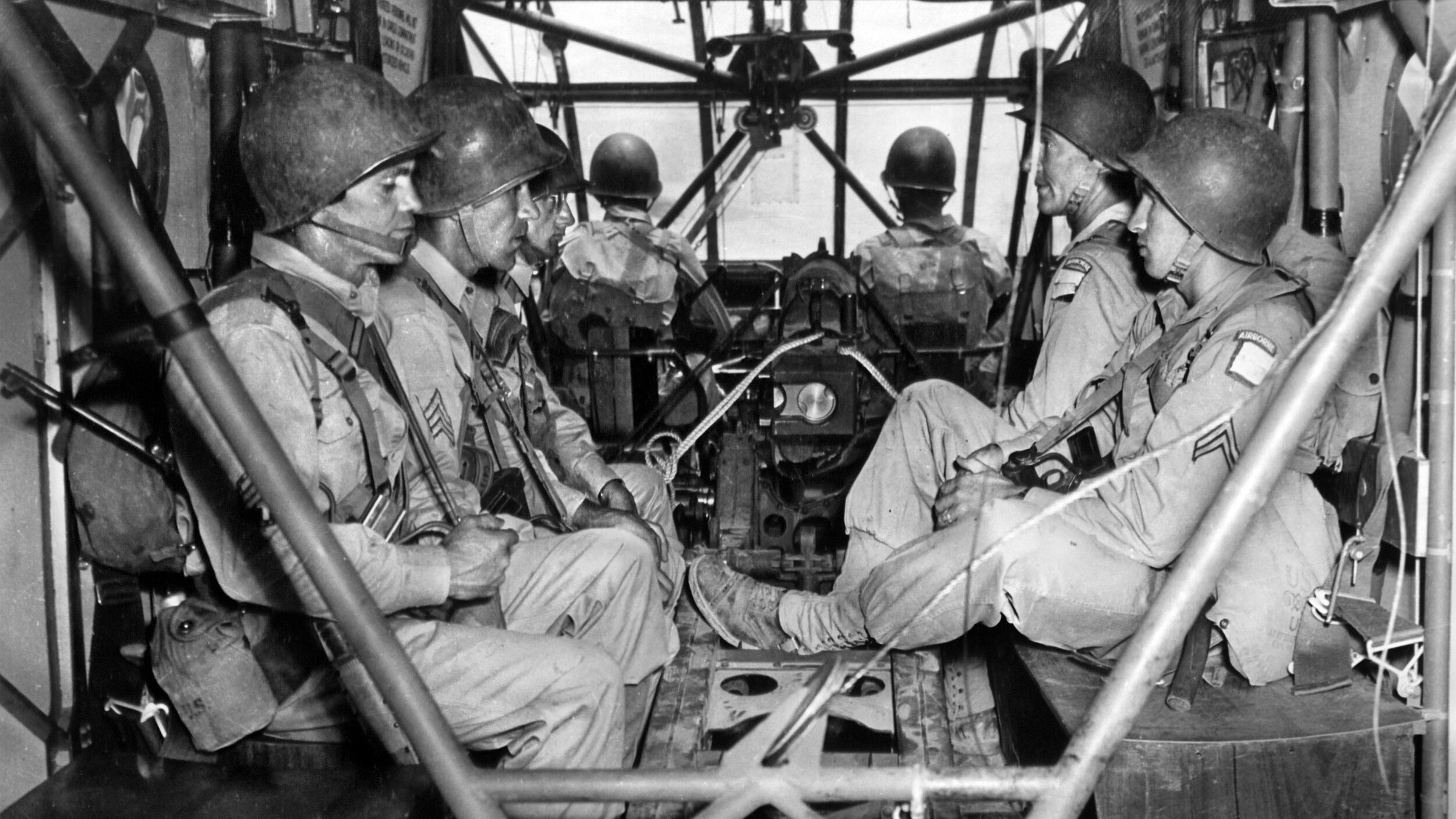
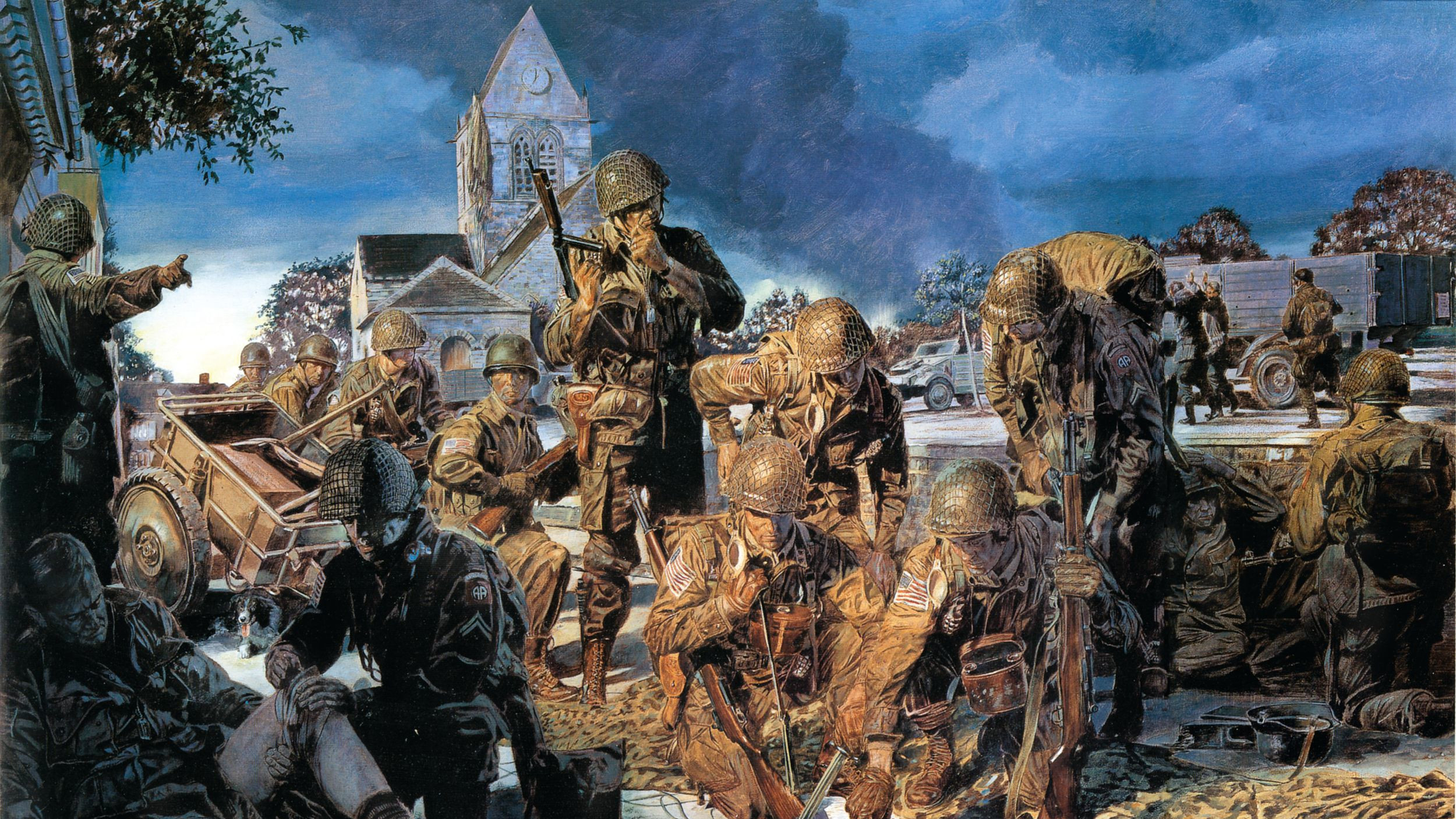
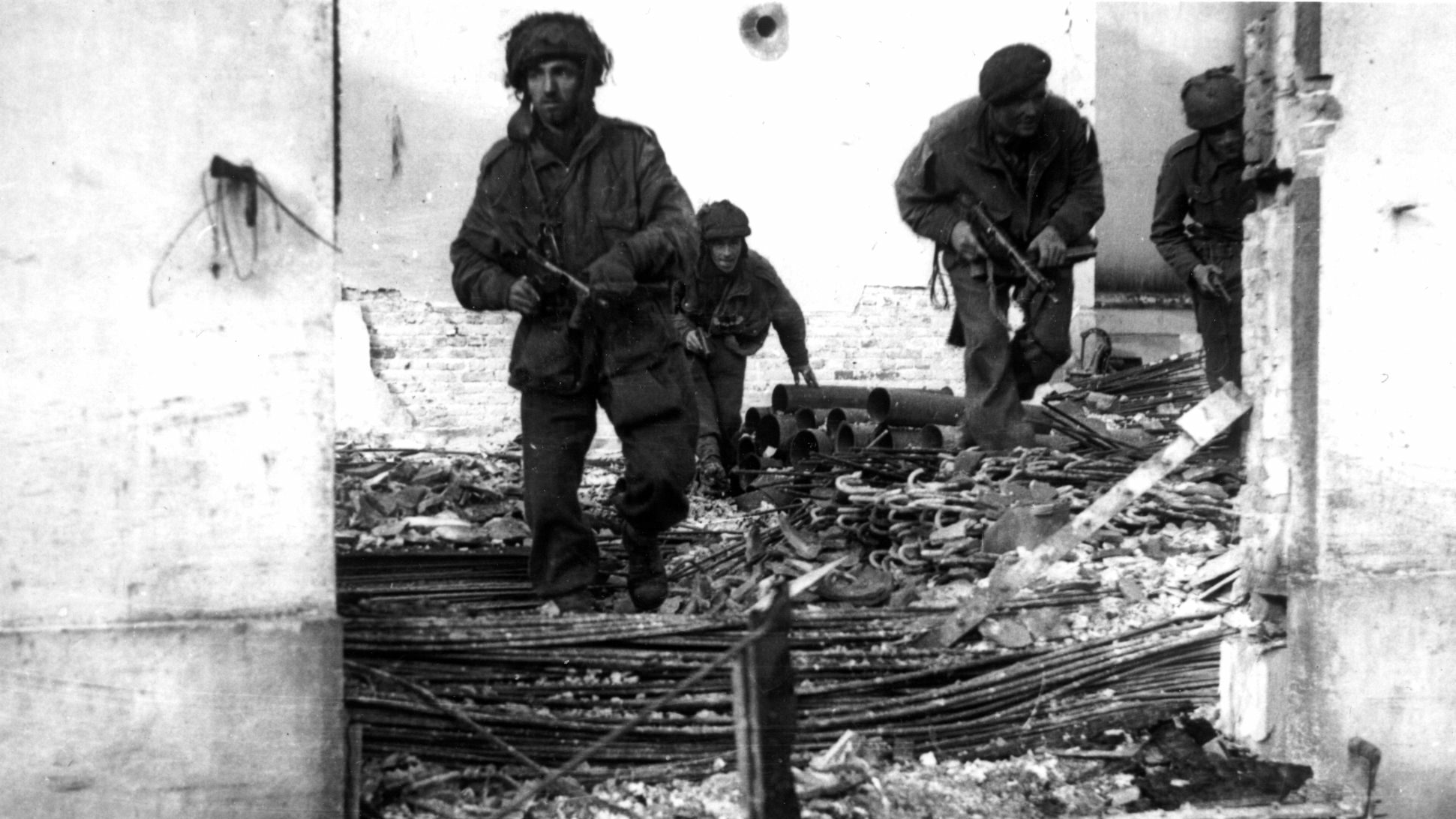
Great article about the battles, I enjoy studying the war particularly the Eastern front. I’m from Moscow myself and had many of my relatives fought in those battles. Thank you for the great information, giving a great understanding of the situation at the time and the units involved as these were the most important elements of the war. The Red army men enduring unimaginable to conditions, fighting absolutely to the death were those men that saved the world.
Samir, I too greatly enjoy reading of the war in Russia. Russian forces suffered beyond any descriptive words. I could make the augment that without the Soviet forces and our cans of Spam along with other lend lease materials the allied landing in France likely would have failed. Yes, I loss a cousin in the Pacific war.
Regards, David Seeds, Florida